The role of monocular viewing in pictorial appreciation
Abstract
Although perspectival projections of three-dimensional subjects to picture surfaces presuppose a single point of view, which can be occupied only by one eye, monocular viewing of perspectival pictures is virtually never practiced, even in cases where the optimal pictorial "illusion" can be experienced only by that mode of vision. This paper argues that the neglect of monocular viewing is a mistake. It cites the benefits accruing to well-managed monocular viewing, considers reasons underlying the indifference, not to say disdain, with which it is commonly regarded, and argues that all of them are rooted in error or in an insufficiently enterprising approach to pictorial artistry.
In the opening chapter of Languages of Art, Nelson Goodman
famously disparages commonplaces about pictorial verisimilitude. Among the
many beliefs he assails is the notion that pictures do or could resemble perceptual
images in ways that serve the cause of a resemblance theory of depiction.
Proponents of perspective in particular come in for correction. For, he says,
not even the packet of light rays delivered to the eye by a picture in correct
perspective can match the bundle delivered to the eye from the object thus
limned. At most it does so only under conditions that he says are "grossly
abnormal." Approximations to identity of stimulus are achievable only
for a single eye at one point only with a stipulated line of sight –
and, he adds, to an eye frozen in place gazing through a peep-hole. This is
obviously not the way we customarily view pictures. "Pictures are normally
viewed framed against a background by a person free to walk about and to move
his eyes."(LA 13) The conditions assumed by the "perspectivists,"
as we might dub them, are so artificial that reliance on them, he says, makes
for "an odd and futile argument for the fidelity of perspective."
(LA 14)
Goodman is certainly right that monocular viewing from a selected
point is not the standard way of viewing pictures. Further, he may be right
that even under the most rigorous conditions perspective cannot deliver precisely
the same bundle of light rays.1 But all that
is fully consistent with the thesis I wish to defend, namely that monocular
viewing from that privileged point has a vital role to play in the understanding
and appreciation of perspectival pictures, and that it should by no means
be regarded as idle or abnormal. This issue is one that long antedates Goodman.
The role of monocular viewing of pictures has been almost totally neglected,
or perhaps one should say suppressed, for several centuries in spite of clear
evidence of its relevance. But, I will argue, there are compelling reasons
why we should rescue it from oblivion and integrate it into our viewing practice.
Given the nature of perspective and the early literature dealing
with it, our philosophic curiosity should be piqued by the fact that we don't
spend time gazing from a privileged point of view with one eye only at pictures
even when the making of those pictures is tied absolutely to the visual appearance
obtained only through that mode of perceptual address. There is no doubt whatever
that perspectors, as they are sometimes called, aim at producing a bundle
of light rays at what I will call the E-point which is in significant ways
highly similar to the bundle delivered to the eye by the intended subject.
2 And for good reason. Thereby the compliant viewer obtains a remarkably
robust and accurate "illusion" 3 of
something very much like the intended subject. When the E-point stands not
more than six feet from the picture plane and the perspectival markers are
clear the force of the illusion significantly exceeds that achievable by binocular
viewing from the E-point. 4 The difference is
even more striking between the optimal monocular illusion and the binocular
illusion sustained throughout what I will call the R-range, that is, the area
normally considered relevant for clear perception of the subject matter of
the picture. To my mind the more palpable sense of fictive depth generated
monocularly would seem by itself to be a sufficient recommendation. Why has
this advantage not been recognized and acted upon?
I ‘ll hazard some explanations in due course. But first
there is more to say about the sort of monocular viewing I have in mind. The
extreme conditions Goodman cites, and ridicules, will certainly not do. First
and most notably, the single eye need not and must not be frozen. It must
be free to scan once it's at the E-point, just as our two eyes scan in normal
picture viewing. In my experience revolving the eye from a given point does
not appreciably change the image. Further, optimum results are obtained by
finding the E-point experimentally, which means moving about within the R-range
so as to appreciate how the virtual object, as I will call it
5, shifts from deformity to rectitude as the proper point of view is
assumed. This has to be repeated to take in the various parts of the picture
if one wants to attain a sharp awareness of the entire fictive space.6 Hence the optimal monocular experience is a cumulative affair drawing
on many fixations and angles of viewing, with concomitant changes of depth
of focus when looking at different parts of the picture.7 Secondly the peep-hole may be finessed. 8 The illusion is certainly enhanced by close framing of the view, as it is
for binocular viewing too. But monocular viewing sans peep-hole already enjoys
an advantage over its binocular counterpart since it automatically reduces
the field of view (especially for long noses), the moreso for pictures with
an E-point within the critical range of about ten feet where stereoscopic
vision is required for fine discrimination of distance. 9 For this and other reasons my recommendation of monocular viewing does
not include either peep-hole or framing. But I think we should keep an open
eye toward these illusion-enhancing devices.
One benefit of the stronger pictorial illusion is that it causes
the pictorial space to connect in a more palpable way with the viewer's space.
The result is a distinctive sense of two worlds connecting, of the viewer
sharing a scene with fictive personages within the picture space. In the viewer
this connectedness awakens a more extensive web of impulses and recognitions
than is otherwise stirred. Another consequence is a sharpened awareness of
substantive credibility and consequently of pictorial accuracy. This has three
sides. First forms look more convincingly regular or distorted, as the case
may be. When the forms are credible the picture is credible. Secondly the
persistent monocular viewer develops an enhanced ability to detect pictorial
accuracy and inaccuracy when viewing in the normal way – binocularly
walking about in the R-range. One's eyes become more prickly, so to speak.
Thirdly in viewing monocularly one is enabled to participate more vitally
with the artist in her management of the projection, in building it and very
often playing with it, complicating or skewing it for artistic effects. Without
becoming a practiced monocular viewer much of this is lost on one, which partly
explains the widespread neglect or underanalysis of this basic part of pictorial
art in most present-day commentaries. Mostly this aspect of pictorial creation
is relegated to specialists dealing narrowly with projection systems rather
than treated as a fundamental part of art-historical or art-critical studies
of individual pictures.
In the nature of the case illustrations of the efficacy of monocular
viewing cannot be very effective for an audience spread over any appreciable
area. One's best demonstrations to a group are somewhat circumstantial. They
give reasons but can't be definitive. With that understanding consider the
following examples. (See list at end for technical details.)

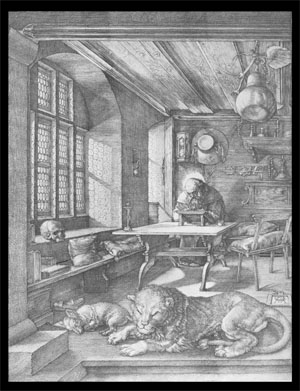
The first is an instructional engraving by Vredeman de Vries.
The second is an engraving by Dürer depicting St. Jerome in his study.
The third is an architectural painting by Pieter Saenredam. In all three cases
the axis is off-center and the E-point close. This makes them ill-suited for
normal viewing. The tomb in the de Vries looks skewed. In the Dürer the
saint's table looks rhomboidal and the gourd seems to hang crookedly.
10 In general the perspective seems unnaturally accelerated. The Saenredam
cleverly avoids offending commonsense by cropping: it shows only a slice of
the columns to right and left. 11 If we expand the picture to include more of the columns to the right, as in
the Photoshop transform (click on image), we see what grotesque enlargement
and deformation is hiding just off-stage.
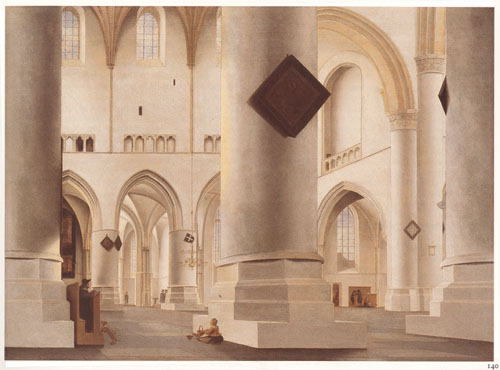
In each of these cases the apparent distortion vanishes when
the picture is seen from the E-point, which requires monocular viewing because
of the closeness of that point. Rhomboids become rectangular, oblongs contract
into squares and in general the pictorial space acquires the fullest rectitude.
It also connects solidly with the viewer's space.
By the same token if one continues to look with one eye only
but shifts away from the E-point all that rectitude slides into perversity.
The virtual object shifts and squirms far more than it does for binocular
viewing. 12,13 At least in cases like these
it seems obvious that a prominent role should be given to monocular vision.
And while this type is a particularly flagrant example the art of the old
masters provides plenty of problematic cases, far more than could be guessed
from art historical studies.
Here are two other sorts of cases. The first relates to the
distance of the subject from the fictive viewer. Subjects are very often shown
as if close up when the perspective implies a much greater distance, as in
Caravaggio's Supper at Emmaus. 14
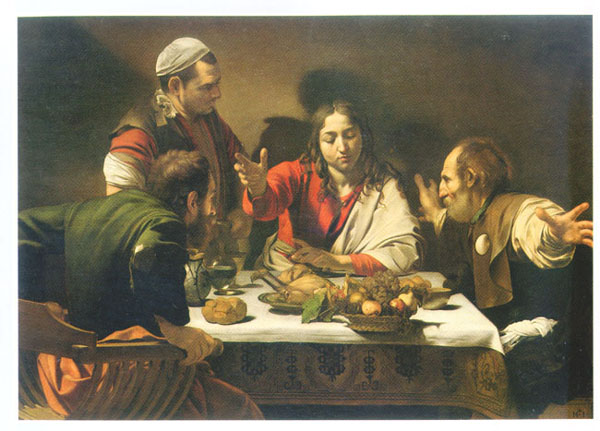
The size of the figures in relation to the on-stage setting
compels the eye to see the scene as close up, perhaps five feet off. Yet the
convergence of forms with distance is radically reduced: St. Peter's distant
right hand is hardly reduced at all compared with his close-up left hand.
Other forms are treated similarly. Based on convergence the scene must be
about seventeen feet away from the fictive viewer. The magnitude of the difference
is displayed first in a transform that alters convergences to fit the apparent
nearness of the scene. (click on image) The next pair of exhibits shows
how the original and the transform should be viewed to conform to the distance
implied by their respective convergences.
The second case plays with the implied level of figures in relation
to the setting. Figures are shown from the viewer's level even when the setting
implies they are above or below it. Perugino's Sistine fresco, Christ giving
Peter the keys to the kingdom, is a typical example.

The transform that is paired with it (click on image)
shows how different a consistent rendering of figures and setting would be.
15 Spatial inconsistencies of this sort are not usually noticed by
most viewers and are mentioned only occasionally in the literature. Recently
David Hockney 16 created a stir about the use
of the camera lucida and pursuant to that cited many examples of the collage-like
insertion of figures on the viewer's level into higher or lower positions.
The relevance of this for my thesis is that monocular viewing is not nearly
so easily fooled or so little observant on this point as is normal walkabout
viewing.
Of course some may say that too much keenness of observation is an aesthetic
or even artistic detriment, that spatial inconsistencies are merely technical
foibles not aesthetic demerits, best honored by neglect or oblivion. But against
this stands the principle on which I stand, that our picture-viewing should
be fully observant of the attributes which create and nuance the pictorial space,
and that it is not enough to be merely informed of them. The features I am concerned
with differ from those that are properly relegated to the technicians, such
as the micro-properties of the support or the layer of paint. The features of
present concern are more like the properties of line. To say we shouldn't notice
spatial anomalies would be like saying we shouldn't sense the wiriness of Michelangelo's
line that edges the fictive cheek or flank turning into depth. Surely, one would
think, picture-viewing at the level of art should try to plumb the image for
its secrets and base appreciation and critical judgment on the totality of the
manifest properties, so far as possible.
On another front monocular viewing can be useful. When we view parallel projections
monocularly their spreading with distance is sharpened. Thereby the distinctive
powers of perspective are more stunningly affirmed. To be sure, binocular viewing
is not completely bereft of these effects, but vivacity is lost. In binocular
viewing of pictures with strong spatial markers and E-points lying within the
critical distance, we imagine more and see less. We read more and see less.
We must note or figure out things that in monocular vision we can directly see.
In binocular viewing the surface intrudes too much into our awareness of the
pictorial space. All that reality interposes a veil between us and the virtual
object. So much lies flat on the surface and refuses to recede that the fictive
scene can never entirely break through, or to vary the direction, we can never
quite break through it. In monocular vision we sail through the veil –
almost.
[The almost is important. The graininess is there, the splotchiness is there,
in ways particular to the technique. In Dürer's St. Jerome the speckles
of the engraving adhere more to the fictive surfaces, cling to the objects,
fill the atmosphere rather than merely lying on the picture's surface. In short
some textural effects are sharpened or altered compared with their
counterparts in binocular viewing. This cannot fail to be aesthetically notable.
I confess I find it intriguing partly because of the changed ontological status
surface grain acquires as qualifying the depicted subject rather than, or in
addition to, the surface.]
But if all this is true, what accounts for the neglect of monocular viewing?
Some of our resistance comes, I think, from the dictum that first and foremost
the artist creates a surface design, with its corollary that the viewer's primary
interest should be in that design, not in the pictorial illusion, if any. The
proper riposte to this line is that perspectival pictures were typically made
to be appreciated as much for the illusion as for the design. This artistic
aim was traditionally discussed under the heading of "invention,"
by which was meant the embodiment of a pictorial idea, the staging of the figures
and scenery in a tableau. 17 Great artists made
great tableaux: Raphael, Caravaggio, Rubens. Lesser artists were typically deficient
in invention. Over time invention was upstaged by surface design. Pictorial
space lost much of its interest for progressive painters. The effects of this
shift are still with us.
In this context it seems to be the very vivacity and substantiality of the
monocular illusion that worries aesthetically savvy viewers. The sparse references
to pictorial illusion found in the literature seem best explained in terms of
the viewer's lessened awareness of surface properties while the illusion has
us in its grip. Other plausible reasons for anxiety are (a) a general sense
of lessened perceptual competence regarding the world at large, (b) an unwelcome
sense of confinement within a single viewing location, and (c) uneasiness at
the loss of aesthetic distance.
These are all relevant concerns. But do they justify the disdain with which
monocular viewing is typically regarded? They would do so if monocular viewing
were proposed as the only or even the dominant mode of viewing.
18 Or if such viewing made us less discriminating in our binocular walkabout
viewing. But what reason is there for thinking that it has these effects? I
find alternating between modes easy, as well as enriching not to mention pleasurable.
It seems to me I see more deeply into pictures by deploying the powers of monocular
as well as those of binocular vision. Am I fooling myself?
The best case against monocular viewing, I think, would draw on the fascinating
line taken by Michael Kubovy, one that takes off from a property of perspectival
pictures (and not just perspectival ones), namely that spatial properties are
generally quite "robust" viewed in the normal walkabout way. This
means that the properties of depicted objects seem not to change with change
of point of view providing we can see the surface of the picture. We may appreciate
that we are not seeing them optimally but our cognitive systems are able to
make fairly good allowances for the change of angle or distance of viewing,
so that in a certain sense and to a certain extent the properties seem constant.
Now one can put this together with the fact that artists over the centuries
exploited this robustness in various ways. For instance Perugino does just this
when he presents figures from a different level than the space they inhabit.
Artists also often present spaces as if seen from above or below the viewer's
level, counting on the painting to induce in the viewer a sense of elevation
above or depression below her actual level. From these premises one might infer
that artists count on viewers using a mode of viewing that ignores or overrides
the formal anomaly. And this finally might be taken as a reason to avoid monocular
viewing, since that mode is precisely not (so) robust in the required way.
To this I propose two answers. First, many pictures are perspectivally consistent,
so the argument does not apply to them. The most proved by the argument would
be that monocular viewing should be restricted to perspectivally consistent
paintings. Second, robustness in not absolute. Granted, normal viewing at some
level of discrimination sees the figures and level ground in a work such as
Perugino's Christ giving the keys to Peter as being viewed from the same
level; but at another, higher level of discrimination it does not. For even
binocularly the discrepancy becomes clear to careful viewers. Similarly for
more radical cases, such as El Greco's Sts. John Evangelist and Francis.
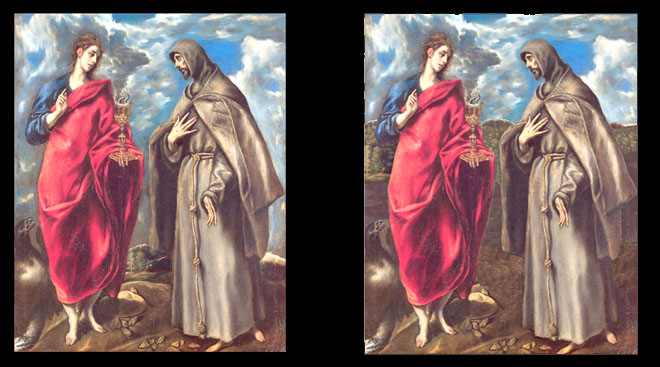
Here we have a first, landscape horizon at knee level; and a second horizon
for the figures at the brim of the chalice. This is in fact an ingenious solution
to a subtle artistic problem. The lower horizon connects the worshipper with
the landscape setting, which is placed at her height. The saints' horizon raises
them into an ethereal domain proper to their status as visionary presences.
Reconcile the two by raising the landscape and the saints are demoted to sojourners
in the Toledan countryside. The essential point at present is that even the
binocular walkabout viewer if alert and persistent will detect, consciously
or preconsciously, El Greco's spatial conceit, that is, will sense the tension
between the different horizons/points of view.
Thus the question is, what level of insight or conscious awareness is optimal?
To this there is, I think, no simple answer because there is no single reason
for looking at pictures. Pictures have many publics, who bring different interests.
Viewers within a single public have different interests at different times.
What we can say, I think, is that those whose interest is directed on the artistic
character of the work, as ours in this society presumably is, have reason to
seek to sharpen and extend their perceptions of the perspectival features, including
the anomalies, and to wring from the work all its divers appearances, the skewed
as well as the regular ones Also we should not oversimplify the interests of
the public in Perugino's or El Greco's time. No doubt the artist did not expect
his sleights of hand to be detected by the public at large. But there is reason
to think that they did expect this of the insiders, the cognoscenti. While our
history has made us more cognizant than they, judging from the indications they
have left, the continuity between their interests and ours is also undeniable.
Their reasons for being fascinated by pictorial art were not so different from
ours that they would not acknowledge our high ambition as kindred to theirs.
Hence my modest conclusion: art-grade viewing (viewing that does justice to
art-grade works) requires a well-considered regimen of monocular and binocular
viewing for the large majority of perspectival paintings. To say this is of
course not to say exactly how important monocular viewing is in relation to
other modes, nor is it to spell out a viewing strategy. That is something one
has to discover by visual exploration coupled with the articulation of findings
about and interpretation of the work. Given the present neglect of monocular
viewing one cannot know how great an advantage it will prove to be if it is
taken up in earnest. All I have attempted here is to persuade you that the payoff
is likely to be considerable. 19
Illustrations
- Vredeman de Vries, plate 23 of Perspective, Second Part, 1604. 6
5/8 x 10 in.
Dürer, St. Jerome in his study, 1504. 9 7/8 x 7 3/8 in
Pieter Saenredam, Interior of St. Bavo's Church, Haarlem, 1637. 23.5
x 32.1 in.National Ga;llery, London.
Photoshop expansion of Saendredam's painting
Caravaggio, Supper at Emmaus, c. 1600. 48 x 79.5 in. (or 54 3/4 x 76
3/4 in.??) National Gallery, London.
Photoshop transform regularizing the perspective of Caravaggio's painting
Perugino, Christ presents the keys to St. Peter, 1481. Approximately
14 x 24 ft. Vatican, Sistine Chapel.
Photoshop transform unifying the two horizons in Perugino's painting
El Greco, Sts. John the Evangelist and Francis, c. 1610. Uffizi Gallery,
Florence.
Photoshop transform of El Greco's painting unifying the two horizons
Line drawing of houses in oblique projection.
- Chinese court artist under the Ch'ien emperor (1736-95). Hanging scroll.
Activities of the Months: The Twelth Month. 69 3/4 by 38 inches. FreerArt
Gallery, Washington, D.C.
Endnotes
1. The book at once richest and most reliable in regard to data and interpretations
concerning the aspects of perspective relevant to my interests is Michael Kubovy
1986. Particularly central is his discussion of the many ways in which perspectivists
in art knowingly deviate from geometrically correct perspective in the interest
of viewers' impressions of fidelity – that is, in the interest of what
I call efficacy as opposed to objective accuracy, which he calls perception
being favored over geometry. I believe the case I have built for monocular viewing
is fully compatible with Kubovy's findings, though I cannot be sure he would
agree with me about its importance.
2. I trust it will be understood that I am not taking issue with Goodman's
opposition to the hoary doctrine of the innocent eye (by now something of a
red herring). Nothing in the current paper presumes anything regarding how freighted
our perception is with concepts, prejudices, needs, etc. Perhaps it is less
obvious that nothing I say in support of monocular viewing presupposes what
is called the illusion theory of depiction (e.g., as expounded and criticized
in Lopes 1996). To cover all bets I hereby affirm that it is so.
I also disavow any notion that pictorial representation is merely natural rather
than conventional. The role of convention in any pictorial tradition is extensive
and many-sided. This is obvious at the level of literal subject matter, where
it follows from the nature of a projection of a three-dimensional subject on
a two-dimensional plane. Necessarily an infinity of different subjects will
comply with any such projection. And that is only the tip of the iceberg.
3. Throughout the paper I use "perspective" in the technical sense
for a projection in which the orthogonals (representing paths in perpendicular
to the foremost shown plane in picture space) converge to a vanishing point.
Parallel projection schemes are not perspectival in this sense. Inverse or reverse
perspective absent the qualifier also falls outside the term as I am using it,
as do any number of other shifts (disappearing axis, etc.) On the other hand
it is unfeasible to exclude all inconsistent schemes, ones with more than one
horizon or where figures are presented orthogonally in an otherwise perspectival
setting. Hybrid schemes mixing parallel and perspectival projection, which abound,
are best called hybrids. No single classification handles the totality of cases
elegantly. The world of pictures is a snakepit of expediency. I use "pictures"
only for designs that represent coherent spaces, unlike some recent theorists,
e.g. Dominic Lopes (1996, 5-6) whose use of the term embraces nonfigurative
designs, e.g. Pollock's drip paintings. The advantage is that "picture"
is tightly linked to "pictorial," "depict" and "depiction,"
as is not the case with the wider usage.
4. Multiple considerations incline artworld exhibitors to deny the viewer easy
access to the E-point. In museums the tidiness of the decor is deemed more important
than availability of the E-point. In a recent exhibition of painting in Delft
in the time of Vermeer the proper viewing station often required bending, craning,
and kneeling. In many historical monuments the constraints are frequently much
worse, for a wide variety of reasons. Piero della Francesca's great cycle, The
Legend of the True Cross, to cite one of countless examples, has E-points
accessible only from the successive levels of a scaffold. The view from the
floor is hopelessly oblique. On the other end of the spectrum, photographic
reproductions in art books usually present images too small to view from the
right distance. Of course we can get something significant even from ill-mounted
or ill-scaled images. But just as obviously we suffer a loss. None of this should
persuade us that it doesn't matter whether we can see a work's space optimally.
It just shows that good access isn't the only thing that matters.
On the other hand the denial of access to the E-point may serve a worthy artistic
purpose. For instance it may carry visually potent symbolism. Leo Steinberg
(1973, 2001) for one gives that optimizing interpretation to Leonardo's Last
Supper, whose space gets glossed, plausibly enough, as sacred in part through
being out of reach for its intended audience. If we want to experience the painting
as Leonardo planned for that audience to see it, we will view it from various
stations standing on the refectory floor. But if we wish to see it as he envisaged
it we must mount a scaffold – though then we must still deal with its strong
ambiguities of distance (Wright 1983, 94-8; Kemp 1990, 47-9; Steinberg 1973,
2001, Kubovy 1986, 144-9).
5. One more qualm might be well to allay. One might think that the twofoldness
championed by Richard Wollheim would be compromised by indulging in monocular
viewing. I have granted that the illusion very much reduces, and sometimes obliterates,
simultaneous awareness of surface features. Of course monocularity never for
a moment obliterates our awareness that what we are seeing is an artifact created
by a painter. But plainly the sort of twofoldness Wollheim takes to be foundational
for pictures (and indeed for graphic designs that are not in my sense pictures)
is not thought of as requiring monocular viewing for keenest perceptual apprehension.
Should we be put on guard by the fact that twofoldness of his sort is attenuated
by monocular viewing?
First it should be noted that momentary reduction or loss of twofoldness is
a problem only if the requirement is that proper picture-viewing must uniformly
be twofold. What could be meant by "proper" in this context? Is it
that any recognition relevant to the understanding, appreciation or assessment
of the picture must be accessible to binocular viewing (from anywhere in the
R-range?)? If so, then such a one cannot require monocular viewing. But what
a strange idea this is, what an arbitrary limitation given the relation of monocular
viewing to perspectival projections. Twofoldness in so rigid a form is certainly
not a valid constraint on pictorial experience. It is not at all difficult to
imagine pictures which can be seen as such only under highly abnormal conditions
– abnormal that is to their intended use. We might know they are pictures
yet confess that we cannot see their surfaces at all absent picture-alien tests,
as by reflections cast on their surface. In the same way one knew there was
glass covering those marvelous Fifth Avenue shop vitrines even though being
concave they could absolutely not be seen from the normal viewing range. Furthermore
one could see that the glass was there if one could find any visual evidence
at all, for instance a ridge of glass at the join with the side wall. Similarly
one certainly could see a super trompe-l'oeil as a picture even if one could
not experience the surface except vestigially, for instance by moving one's
head and finding no corresponding 3D shift in the depicted scene. One would
simply not be able to see the surface and consequently would be barred from
much that is relevant to the understanding, appreciation and assessment of it
as a picture. In regard to this matter I am happy to be able to cite the trenchant
criticism of twofoldness given by Dominic Lopes (1996, 39-51). His only omission
regards my pet preoccupation, namely monocular viewing.
6. My experience suggests that monocular viewing works as well as it does in
part due to its narrowing of the effective field of view. This inclines me to
think it would be worth while experimenting with an eye-shade attached to my
glasses' frame, to match my nose on the inside. But one has to accustom oneself
by stages to flouting decorum in museums. It is already a stretch to assume
the posture needed to bring one's eye to the E-point.
7. Monocular viewing is especially recommended for viewing small-scale reproductions,
which necessarily have close E-points. In this age of mechanical reproduction
a disproportionate share of our viewing is of these rather than the originals.
The result is that monocular viewing is more important for us to practice than
is was for any of our predecessors.
8. Traditional art-theoretical literature seems oblivious to the specific spatial
anomalies noted in this paper. This is remarkable in view of the attention lavished
upon painterly management of coloring and tone for the sake of creating depth
effects. Ivan Gaskell kindly called my attention to a particularly insightful
recent treatment of this subject by Paul Taylor, "The concept of houding
in Dutch art theory," Journal of the Warburg and Courtauld Institutes,
volume 55 (1992), pp. 210-33. The artifices employed aimed at making individual
features at all depths both clear and clearly located in their proper place.
Houding is described as a certain sort of harmony, which I take to be harmony
of the appearance of the individual features with the perspectival markers with
which I have been concerned. Just how this coloristic aspect of the pictorial
illusion relates to spatial anomalies is unexplored terrain.
The closest thing to a declaration of the artist's freedom to violate spatial
integrity known to me occurs in Goethe's conversations with Eckermann, dated
1827, in which he praises Rubens' use of sunlight coming from two quite different
directions (the work he refers to is now given to Lucas van Uden). See Goethe
on Art, translated and edited by John Gage, 1980. (Berkeley: University
of California Press). This is not quite the same as perspectival inconsistency,
but Goethe's principle that the artist stands above nature would certainly include
freedom with respect to spatial inconsistencies.
References
- Aumont, Jacques, 1994. The Image. London: The British Film Institute.Arnheim,
Rudolf, 1954. Art and Visual Perception. Berkeley: University of California
Press.
Budd, Malcolm, 1993. "How Pictures Look." In D. Knowles and J. Skopuroski
(eds.), Virtue and Taste.
Oxford: Basil Blackwell.
Dandré-Bardon, M.-F. 1767. Traité de Peinture. Paris.
.
Dubery, Fred , 1983. Perspective and other Drawing Systems. London:
The Herbert Press; New York: Van Nostrand.
Gibson, J.J., 1971. "The Information Available in Pictures." Leonardo
4, 27-35.
Goodman, Nelson, Languages of Art, 1968. Indianapolis and New York:
Bobbs-Merrill Company.
Gombrich, Ernst, 1960/1988. Art and Illusion: A Study in the Psychology
of Pictorial Representation. Oxford: Oxford University Press.
Gregory, Richard L., 1970. The Intelligent Eye. London: Weidenfield
and Nicholson.
Hagen, Margaret A., 1986. Varieties of Realism: Geometries of Pictorial
Representation.
Cambridge: Cambridge University Press.
Henle, Mary (ed.) 1976. Vision and Artifact. New York: Springer Publishing
Company.
Hermeren, Gören, 1969 Representation and Meaning in the Visual Arts.
Scandanavian University Books, Lund.
Hockney, David 2001. Secret Knowledge: rediscovering the lost techniques
of the old masters. New York: Viking Studio.
Hyman, John, 1989. The Imitation of Nature. Oxford, Basil Blackwell.
Kemp, Martin, 1992. The Science of Art: Optical Themes in Western Art from
Brunelleschi
to Seurat. New Haven, Conn: Yale University Press.
Kennedy, John M., 1974. A Psychology of Picture Perception. San Francisco:
Jossey-Bass Publishers.
Kubovy, Michael 1986. The psychology of perspective and Renaissance art.
Cambridge: Cambridge University Press.
Lopes, Dominic, 1996. Understanding Pictures. Oxford: Clarendon Press.
Perkins, David, and Leondar, Barbara (eds.), 1977. The Arts and Cognition.
Baltimore and London: The Johns Hopkins University Press.
Pirenne, M. C., 1970. Optics, Painting and Photography. Cambridge:
Cambridge University Press.
Podro, Michael, 1998. Depiction. New Haven and London: Yale University
Press.
Schier, Flint, Deeper into Pictures, 1986. Cambridge: Cambridge University
Press.
Steinberg, Leo, 1973. "Leonardo's Last Supper," The Art Quarterly
XXXVI, 4.
Steinberg, Leo, 2001. Leonardo's Incessant Last Supper, New York: Zone
Books.
Strauss, Walter L., 1972. The Complete Engravings, Etchings and Drypoints
of Albrecht Dürer. New York: Dover Publications.
- Walton, Kendall, 1990. Mimesis as Make-Believe. Cambridge: Harvard
University Press.
- ___________, 1987. 'Looking at Pictures and Looking at Things,' in Andrew
Harrison (ed.), Philosophy and the Visual Arts. The Hague: D. Reidel.
- Willats, John, 1997. Art and Representation. Princeton: Princeton
University Press.
Lawrence Wright, 1983. Perspective in Perspective. London: Routledge
and Kegan Paul
Richard Wollheim, 1987 Painting as an Art. Princeton: Princeton University
Press.
Observations and documentation of the illustrations
1. In studying the perspectival aspects in a Chinese painting The Twelfth
Month – see thel illustration below– it
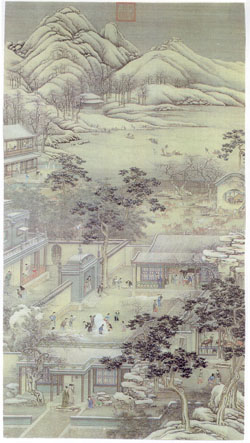
becomes clear that one has a wrong idea of the proportions of the buildings
unless one studies the image carefully with one eye only. To make the rectangular
forms (houses, patios, yards) look convincingly rectangular one must see them
from the right side fairly high up. This conforms to the mildly convergent orthogonals
and the elevation of the far edge of the lake. The unwary viewer at first thinks
the architecture is presented in parallel projection. But that impression results
from too casual viewing. Thus if we want to inform our normal viewing with the
relevant facts about the picture space, we do well to exercise monocular vision.
We discover that besides attending to the vanishing point we must adjust our
distance of viewing for the different levels of the scene. In this, and in other
respects, perspective is combined with an aspect of parallel projection, as
is common in oriental art.
2. Commentary on the illustrations to be shown during the reading of the paper
(to the extent time permits).
a. Vredeman de Vries, plate 23 of Perspective, Second Part, 1604.
The tomb seems seriously out of square even to binocular viewing when the plate
is viewed head on, although most viewers accept it as square because of subject-matter
conventions. The ordinary viewer resists noticing its eccentricity. Monocular
viewing makes its obliquity more accessible, as it also does the warping the
virtual image suffers as we change our viewing position. Binocular viewing brings
to the fore the design shape on the surface. Monocular viewing lessens awareness
of the design shape because it foregrounds the changing virtual shape. In binocular
viewing it is never easy to forget the design shape. In monocular viewing it
is never easy to remember it. One has to take special note of the projection
shape of the format. When that is rectangular, we are viewing head on. But it
takes an effort to attend to this when we are under the spell of a virtual scene
which looks normal only when viewed obliquely. The de Vries runs the gamut of
virtual deformations in an optimally salient way. It serves as an ideal training
tool for sensitizing viewers to the features of the virtual object.
b. Dürer, St. Jerome in his study, 1504.
In the Dürer we have an art-grade version of off-center representation.
Note especially how the table and the block at the base of the pilaster on the
left square up when the work is viewed from the E-point. Though I have enlarged
it as much as the 8 ½ x 11 inch sheet allows, normally sighted persons
may have difficulty obtaining a clear image from the E- point, which lies about
7 inches from the surface. The original is somewhat too small for normal vision.
Binocular vision at this range is capable of detecting changes of virtual form
but the parallax inherent in it results in a decidedly less faithful image from
the E-point.
c. Pieter Saenredam, Interior of St. Bavo's Church, Haarlem, 1637 and
a Photoshop expansion of Saendredam's painting to show the enlargement of the
projection shapes on the picture surface far from the picture's axis. As Dubery
and Willats point out, the depth effect of the original is much stronger when
the picture is viewed from the left side, since the axis falls almost at the
left margin. The optimum distance of viewing is about 16" from the surface
of the 23.5 x 32.1 in. original and about 7" for the reproduction appended
to the paper, which is comparable to that of the Dürer. Needless to say,
at that short a distance monocular viewing gives a more accurate experience
of the virtual object than binocular viewing can.
Saenredam's cropping of the scene does not (how could it?) altogether avoid
the appearance of deformation when it is viewed head on. The pier of the columns
to the right does not appear square and, more subtly, the right wall of the
building seems to stand at an obtuse angle to the rear wall.
c. Caravaggio, Supper at Emmaus, c. 1600 and a Photoshop transform regularizing
the perspective of Caravaggio's painting.
The virtual non-convergence of St. Peter's hands and the small size-gradient
of near-to-far figures implies a considerably distant view. Boxing the bowl
on the table results in the fictive viewer being placed about 2.6 times the
79.5 inch width of the painting, or about 17 feet. Yet the almost life size
figures and the narrowness of the scene suggest a much nearer view, say 6-8
feet. Dubery and Willats claim that the artistic merit of the inconsistency
is to produce a dual effect of respectful distance (suiting the spiritual stature
of the persons and occasion) and intimacy or immediacy. I think a lesser construction
is also plausible: realism in relation to the normal in situ viewing distance
combined with heightened dramatic impact. Another advantage is a sense of something
being right about the projection from both near and far, which fits our walkabout
viewing habits.
The transform greatly increases the convergence of St. Peter's hands and the
figures: the disciple on the left is much enlarged. Some lesser discrepancies
are also adjusted. The result of the changes is a more consistently close-up
view with a viewing distance of about .8 times the width or 64 inches for the
original and 8 inches for the transform itself, resulting in a visual angle
of around 30 degrees. That is closer than the actual viewer could normally obtain
given the position of the painting over an altar. As to artistic effect, to
my eye the transform is arguably better integrated and spiritually no less appropriate
than the original. The authority of Christ and the spiritual stature of the
disciples seems to me not at all diminished. Monocular viewing of the reproductions
gives a decidedly more vivid impression of the
scene than binocular viewing does.
I've added two displays intended to give some impression of the pictures standing
at distances roughly matching their perspectives. Which one best fits the impression
we have of the original when we see it without any of these problems having
been raised?

d. Perugino, Christ presents the keys to St. Peter, 1481 and several
Photoshop transforms unifying or contrasting the two horizons in Perugino's
painting.
Here the painter's first problem was to present a scene showing both the foreground
array of figures and the piazza when the image had already to be placed so that
its lower border is some twelve feet off the floor. This required an initial
conceit: the scene is presented from above ground level in defiance of the actual
viewer's subterranean point of view. The next problem was how to show two subsidiary
Christological events behind the main feature, Christ and the tax collector
on the left and The attempted stoning of Christ on the right. Only the piazza
is available for them. Thus the main event must be shown from the bleachers,
not from the pictorial ground level. Otherwise the principals would block the
view of the secondary events. But to maintain perspectival consistency (within
the parameters already laid down) this option would require the painter to represent
the figures from above, a task which he was evidently not prepared to undertake
(nor were hardly any of his colleagues at the time). Since painters had to paint
scenes at all levels in chapels, each level requiring a different ‘tilt,'perspectival
realism of figures in relation to the position of actual viewers was an intolerable
can of worms for artists. Thus Perugino did what practically all of his colleagues
did at the time. He simply represented all the figures from their level (head
high). The consequence is generally referred to as that of an uptilted ground.
But with equal justice it might be called that of back-tilted figures.
The transforms show why Perugino had no acceptable alternative to this if he
was to avoid showing the foreground figures from above.
Transform 1 elevates the figures so that their horizon (head-high) coincides
with the landscape horizon, deleting the ground that would open up in front
of them unless their size or their distance from the fictive viewer were adjusted.
(The other option, making them walk on air, is utterly beyond the pale.)
The second transform exercises the option of enlarging the size of the figures,
preserving their position on the piazza and perspectival consistency regarding
the horizon. Two obvious consequences are that the figures advance toward us
and the sidemost of them are pushed into the wings. The balance of figures and
architecture is altered, suggesting an altered idea of the relative importance
of Biblical events and post-Biblical ecclesiatical consolidation.
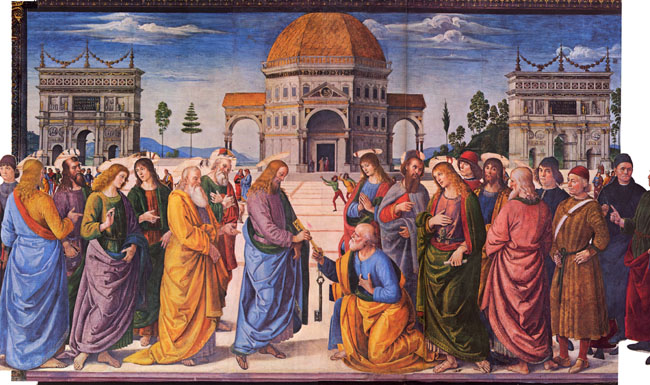
The third transform compares the second option with the original by a split
screen.
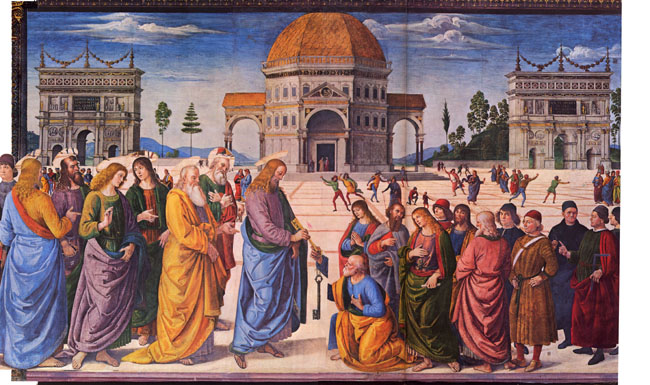
A third option is to flatten out the view, keeping the figural screen as it
was but raising it to the architectural horizon. The foreground can be cropped
or filled in with pavement. In either case the figural screen is pushed somewhat
closer to the buildings.
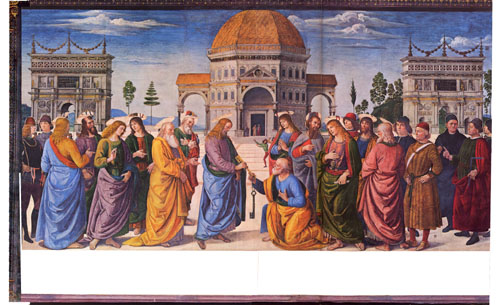
[Further refinements will be made to this section. 2/8/04.]
Transforming the figures to accord with a downward view, as from a terrace
four feet above the pavement, is even more difficult in Photoshop than it would
have been for Perugino, so like him I finesse it.
One benefit of studying these transforms is to sensitize one's eye to variations
in implied horizon, distance, and size of figures, a sensitivity that is keener
in monocular than in binocular viewing, at least for images requiring a close
viewing station. (Admittedly the present painting does not require monocular
viewing, since its size entails a distant E-point, but the reproductions from
which most viewing of "it"occurs do. For a 8.5 x 14 inch reproduction
the proper viewing distance is 20-24 inches. Closer viewing brings the buildings
too close and makes the arches absurdly shallow.)
e. El Greco, Sts. John the Evangelist and Francis, c. 1600 (44 x 331/2
in., Uffizi) and Photoshop transform of El Greco's painting unifying the two
horizons.
This duality of horizons is typical of El Greco's altar paintings of patron
saints. The effect is to make the saints look oversize and, more subtly, visionary
rather than real. When the landscape horizon is raised to match that of the
figures, as it is in the transform, the figures look like sojourners in the
countryside rather than spiritual beings mystically ministering to earthly denizens.
The landscape horizon is at the viewer's level, the saint's horizon stands at
an elevation far above the viewer's. Yet to some degree the viewer is also by
implication lifted up, as a devotee is supposed to be by the act of prayerful
supplication. The saints thereby comes across as spiritually more accessible
than they would seem if presented from below looking up (da sotto in su). El
Greco's solution to the problem of how to present the right combination of implications
is, in my view, ingenious.
f. Line drawing of regularly spaced houses in oblique projection.
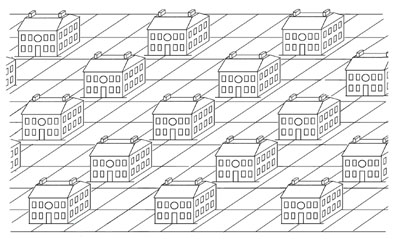
Footnotes
1. LA 19. Here I cannot follow his argument. He claims, without elaboration, that left-right magnitudes are out of scale when we view a picture of a tall building with a low viewpoint, even when the vertical magnitudes are correct. I can't see how this could be the case from the E-point. I am glad to find my impression confirmed by the criticism of Goodman's argument by Michael Kubovy (1986, 122-6).
2. Exact identity (in shape) is by no means required for practical purposes. Further, there are manifold reasons for artists deviating from the full measure of achievable rectitude or withholding cues so that rectitude cannot be judged. None of this impugns the general drift. But see ahead for discussion of this.
3. I know of no term that serves so well for the actual phenomenon, though in this context it does not imply error. To be sure it must be noted that the “illusion” to which I refer has not the force of true stereopsis. Equally the illusion is not “robust” in the sense given by Kubovy , Ch. 4, to robust perspective: pictorial perspective is said to be robust when it seems unaffected by a change of point of view, aping the constancy of forms in perception of 3D scenes. In contrast monocular pictorial illusions are typically highly sensitive to change of position. They also involve the “collusion” of the viewer with the presumed artist. ( Kubovy , Ch. 5)
4. Trompe l'oeil works meant to be viewed within the critical range of six feet work well even for normal viewing because the pictorial subject is so flat that there are almost no prominent perspectival markers.
5. In the case of pictures this might also be called “the visually ostensible depiction subject,” but “virtual object” is handier. As I conceive it the expression implies no dubious ontic entities, only dispositions of the seeming-to-see variety.
6. Here I mean all shown parts of the picture space. The hidden or off-stage parts cannot be sharply known since they aren't shown. But their character is in various respects more or less strongly implied.
7. The distance varies with the angle of light from the given part of the picture to the E-point.
8. Framing which masks out all but the picture is prodigiously inconvenient, since it must vary in size and shape with distance and angle.
9. On distance-discrimination see Kubovy 1986, pp. 43,47.
10. For this reason the work has been accused of violating the rules of perspective, e.g. by W.M. Ivins, as quoted by Strauss 1972, p. 162.
11. I t is praised for this by Dubery and Willats 1983, p-. 87-9.
12. The saint's lion does not fare so happily, however. Animals and humans are rarely projected correctly in an angled view, save in conscientiously illusionistic works such as Andrea Pozzo's St. Ignazio ceiling. Dürer's lion asks to be seen from head on or from much farther away. To that extent the image is not integral.
13. The claim by Pirenne (1970) that when we change our viewing position the forms in picture space do not seem to change is true, to the extent it is true at all, only of binocular viewing and even then of low-discrimination viewing. With application one soon comes to see changes even in binocular vision.
14. Willats and Dubery 1970
15. Other reconciliations are of course possible. The figures may be enlarged in order to preserve the height of the format. Or the figures could be shown from a higher elevation, a feat virtually no artists attempted at the time or indeed afterward. See endnote 9.
16. His Secret Knowledge is highly instructive on the prevalence of the practice. He speaks of the effect as that of many windows, a usage which may mislead. Each “window” is strictly confined to the figure. The setting is singular not multiple, the same for all. Hence “window” is not to be taken in the customary Albertian way.
17. As in Dandré-Bardon 1767, Second Part, Article I, p. 80.
18. I am led to wonder whether there is some philosophic principle that undermines the impulse to venture into monocular viewing. Perhaps we have assumed that there is one best mode of ocular address to pictures. If that were true then as between monocular and binocular viewing the latter would certainly be the proper mode. Binocular viewing is indisputably accommodates the widest range of awareness. More properties relevant to the art of picturing can be accommodated in binocular than in monocular viewing. If we had to choose, we would rightly choose binocularity as the norm. But why should we accept any such principle? Why should we suppose that the relevant visual experience can be comprised within a single mode of address? Isn't that as implausible as saying that there must be one optical fixation, or one path for the eye to follow, for correctly seeing the picture? Or to approach the matter from the opposite direction, isn't it vastly more consistent with our experience that we appreciate and assess the aesthetic worth of pictures on the basis of the sum of relevant fixations, paths, and the like? Relevance is of course tricky to delimit. Within the scope of the relevant, privilege is equally tricky to graduate. But it is plausible to hold that viewing from the E-point is not only relevant but central, absent special conditions. From that it is but a step to the idea that monocular vision deserves to enjoy a certain limited (non-unique) privilege.
19. The relation between monocular viewing and viewing typical (i.e. extreme) anamorphic images is suggestive in various ways. In both experiences the bond between the image and the surface is broken or at least lessened. But there is an important difference. The realized anamorphic image floats so discrepantly free from the surface that scant aesthetic gain comes from trying to view the surface as containing that hidden image (Holbein's Ambassadors not to the contrary withstanding). So one feels with justification that viewing extreme anamorphoses cannot be compatible with serious, art-grade viewing. But it would be wrong to convict monocular viewing on this ground. For it is free of this limitation. The transition between it and the normal binocular mode is easy and smooth, the monocular illusion simply a more vivid, full-bodied and “correct” version of the binocular illusion.











